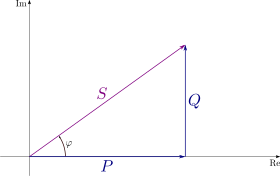교류 전력

교류 전력은 교류 회로의 전력을 말한다. 전기 회로의 일률은 회로의 주어진 지점을 지난 에너지의 흐름 속도이다. 교류 회로에서 유도자와 축전기 같은 에너지 저장 요소는 에너지 흐름의 방향을 주기적으로 반전시킬수 있다.
유효 전력, 무효 전력 과 피상 전력[편집]
In a simple alternating current (AC) circuit consisting of a source and a linear load, both the current and voltage are sinusoidal. If the load is purely resistive, the two quantities reverse their polarity at the same time. At every instant the product of voltage and current is positive or zero, the result being that the direction of energy flow does not reverse. In this case, only active power is transferred.
If the load is purely reactive, then the voltage and current are 90 degrees out of phase. For two quarters of each cycle, the product of voltage and current is positive, but for the other two quarters, the product is negative, indicating that on average, exactly as much energy flows into the load as flows back out. There is no net energy flow over each half cycle. In this case, only reactive power flows: There is no net transfer of energy to the load; however, electrical power does flow along the wires and returns by flowing in reverse along the same wires. The current required for this reactive power flow dissipates energy in the line resistance, even if the ideal load device consumes no energy itself. Practical loads have resistance as well as inductance, or capacitance, so both active and reactive powers will flow to normal loads.
Apparent power is the product of the rms values of voltage and current. Apparent power is taken into account when designing and operating power systems, because although the current associated with reactive power does no work at the load, it still must be supplied by the power source. Conductors, transformers and generators must be sized to carry the total current, not just the current that does useful work. Failure to provide for the supply of sufficient reactive power in electrical grids can lead to lowered voltage levels and, under certain operating conditions, to the complete collapse of the network or blackout. Another consequence is that adding the apparent power for two loads will not accurately give the total power unless they have the same phase difference between current and voltage (the same power factor).
Conventionally, capacitors are treated as if they generate reactive power and inductors as if they consume it. If a capacitor and an inductor are placed in parallel, then the currents flowing through the capacitor and the inductor tend to cancel rather than add. This is the fundamental mechanism for controlling the power factor in electric power transmission; capacitors (or inductors) are inserted in a circuit to partially compensate for reactive power 'consumed' ('generated') by the load. Purely capacitive circuits supply reactive power with the current waveform leading the voltage waveform by 90 degrees, while purely inductive circuits absorb reactive power with the current waveform lagging the voltage waveform by 90 degrees. The result of this is that capacitive and inductive circuit elements tend to cancel each other out.[1]

The complex power is the vector sum of active and reactive power. The apparent power is the magnitude of the complex power.
Active power, P
Reactive power, Q
Complex power, S
Apparent power, |S|
Phase of voltage relative to current,
Engineers use the following terms to describe energy flow in a system (and assign each of them a different unit to differentiate between them):
- Active power,[2] P, or real power:[3] watt (W);
- Reactive power, Q: volt-ampere reactive (var);
- Complex power, S: volt-ampere (VA);
- Apparent power, |S|: the magnitude of complex power S: volt-ampere (VA);
- Phase of voltage relative to current, φ: the angle of difference (in degrees) between current and voltage; . Current lagging voltage (quadrant I vector), current leading voltage (quadrant IV vector).
These are all denoted in the adjacent diagram (called a Power Triangle).
In the diagram, P is the active power, Q is the reactive power (in this case positive), S is the complex power and the length of S is the apparent power. Reactive power does not do any work, so it is represented as the imaginary axis of the vector diagram. Active power does do work, so it is the real axis.
The unit for power is the watt (symbol: W). Apparent power is often expressed in volt-amperes (VA) since it is the product of rms voltage and rms current. The unit for reactive power is var, which stands for volt-ampere reactive. Since reactive power transfers no net energy to the load, it is sometimes called "wattless" power. It does, however, serve an important function in electrical grids and its lack has been cited as a significant factor in the Northeast Blackout of 2003.[4] Understanding the relationship among these three quantities lies at the heart of understanding power engineering. The mathematical relationship among them can be represented by vectors or expressed using complex numbers, S = P + j Q (where j is the imaginary unit).
같이 보기[편집]
각주[편집]
- ↑ “Archived copy”. 2015년 5월 12일에 원본 문서에서 보존된 문서. 2015년 4월 29일에 확인함.
- ↑ Definition of Active Power in the International Electrotechnical Vocabulary 보관됨 4월 23, 2015 - 웨이백 머신
- ↑ IEEE 100 : the authoritative dictionary of IEEE standards terms.-7th ed. ISBN 0-7381-2601-2, page 23
- ↑ “August 14, 2003 Outage - Sequence of Events” (PDF). FERC. 2003년 9월 12일. 2007년 10월 20일에 원본 문서 (PDF)에서 보존된 문서. 2008년 2월 18일에 확인함.


